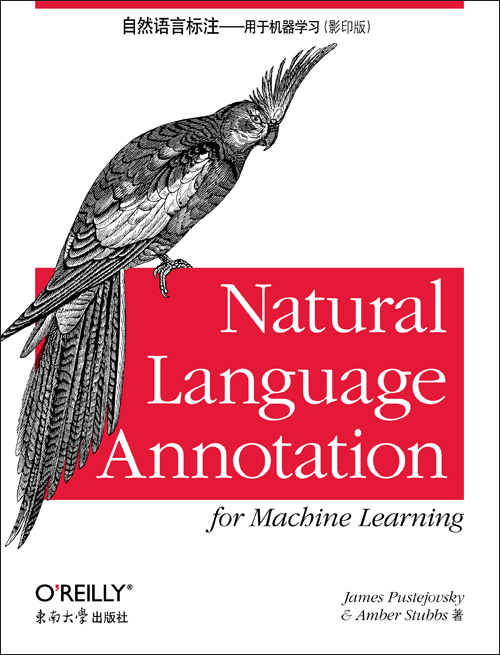自然语言标注——用于机器学习(影印版)
出版时间:2013年06月
页数:344
“语言标注是自然语言处理的关键环节,但是它很少在计算语言学课程中被提及。这是第一本手把手讲解标注的书籍,从规范和设计到使用机器学习算法面面俱到。它必然成为本科和研究生的计算语言学课程的范本。”
——Nancy Ide
Vassar学院的计算机科学教授
本书是O’Reilly出版社的《Python自然语言处理》的最佳伴读书籍。
是时候创建属于你自己的用于机器学习的自然语言训练语料库了。无论你使用英语、汉语或者其他任何一种自然语言,本书都可以手把手地指导你一种经验证的标注开发周期——把元语添加到你的训练语料库中来帮助机器学习算法更有效工作的过程。你无需任何编程或者语言学方面的经验就可以上手。
通过每一步中的详细示例,你将学到“标注开发过程”是如何帮助你建模、标注、训练、测试、评估和修正你的训练语料库。你也将了解到一个实际标注项目的完整演示。
· 在收集你的数据集(语料库)之前定义一个清晰的标注目标
· 学习用于分析你的语料库中语言内容的工具
· 搭建用于你的标注项目的模型和规范
· 检查从基本的XML到语言标记框架这样一些不同的标注格式
· 创建适合于训练和测试机器学习算法的黄金标准语料库
· 选择用来处理你的标注数据的机器学习算法
· 评估测试结果并修正你的标注任务
· 学习如何使用用于标注文本和调整标注的轻量级软件
James Pustejovsky是Brandeis大学的教授,他在该大学的计算机科学系讲解和研究人工智能及计算语言学。
Amber Stubbs刚刚获得了Brandeis大学标注方法论的博士学位。她现在是SUNY Albany大学的博士后。
——Nancy Ide
Vassar学院的计算机科学教授
本书是O’Reilly出版社的《Python自然语言处理》的最佳伴读书籍。
是时候创建属于你自己的用于机器学习的自然语言训练语料库了。无论你使用英语、汉语或者其他任何一种自然语言,本书都可以手把手地指导你一种经验证的标注开发周期——把元语添加到你的训练语料库中来帮助机器学习算法更有效工作的过程。你无需任何编程或者语言学方面的经验就可以上手。
通过每一步中的详细示例,你将学到“标注开发过程”是如何帮助你建模、标注、训练、测试、评估和修正你的训练语料库。你也将了解到一个实际标注项目的完整演示。
· 在收集你的数据集(语料库)之前定义一个清晰的标注目标
· 学习用于分析你的语料库中语言内容的工具
· 搭建用于你的标注项目的模型和规范
· 检查从基本的XML到语言标记框架这样一些不同的标注格式
· 创建适合于训练和测试机器学习算法的黄金标准语料库
· 选择用来处理你的标注数据的机器学习算法
· 评估测试结果并修正你的标注任务
· 学习如何使用用于标注文本和调整标注的轻量级软件
James Pustejovsky是Brandeis大学的教授,他在该大学的计算机科学系讲解和研究人工智能及计算语言学。
Amber Stubbs刚刚获得了Brandeis大学标注方法论的博士学位。她现在是SUNY Albany大学的博士后。
- Chapter 1: The Basics
- The Importance of Language Annotation
- A Brief History of Corpus Linguistics
- Language Data and Machine Learning
- The Annotation Development Cycle
- Summary
- Chapter 2: Defining Your Goal and Dataset
- Defining Your Goal
- Background Research
- Assembling Your Dataset
- The Size of Your Corpus
- Summary
- Chapter 3: Corpus Analytics
- Basic Probability for Corpus Analytics
- Counting Occurrences
- Language Models
- Summary
- Chapter 4: Building Your Model and Specification
- Some Example Models and Specs
- Adopting (or Not Adopting) Existing Models
- Different Kinds of Standards
- Summary
- Chapter 5: Applying and Adopting Annotation Standards
- Metadata Annotation: Document Classification
- Text Extent Annotation: Named Entities
- Linked Extent Annotation: Semantic Roles
- ISO Standards and You
- Summary
- Chapter 6: Annotation and Adjudication
- The Infrastructure of an Annotation Project
- Specification Versus Guidelines
- Be Prepared to Revise
- Preparing Your Data for Annotation
- Writing the Annotation Guidelines
- Annotators
- Choosing an Annotation Environment
- Evaluating the Annotations
- Creating the Gold Standard (Adjudication)
- Summary
- Chapter 7: Training: Machine Learning
- What Is Learning?
- Defining Our Learning Task
- Classifier Algorithms
- Sequence Induction Algorithms
- Clustering and Unsupervised Learning
- Semi-Supervised Learning
- Matching Annotation to Algorithms
- Summary
- Chapter 8: Testing and Evaluation
- Testing Your Algorithm
- Evaluating Your Algorithm
- Problems That Can Affect Evaluation
- Final Testing Scores
- Summary
- Chapter 9: Revising and Reporting
- Revising Your Project
- Reporting About Your Work
- Summary
- Chapter 10: Annotation: TimeML
- The Goal of TimeML
- Related Research
- Building the Corpus
- Model: Preliminary Specifications
- Annotation: First Attempts
- Model: The TimeML Specification Used in TimeBank
- Annotation: The Creation of TimeBank
- TimeML Becomes ISO-TimeML
- Modeling the Future: Directions for TimeML
- Summary
- Chapter 11: Automatic Annotation: Generating TimeML
- The TARSQI Components
- Improvements to the TTK
- TimeML Challenges: TempEval-2
- Future of the TTK
- Summary
- Chapter 12: Afterword: The Future of Annotation
- Crowdsourcing Annotation
- Handling Big Data
- NLP Online and in the Cloud
- And Finally...
- Appendix: List of Available Corpora and Specifications
- Corpora
- Specifications, Guidelines, and Other Resources
- Representation Standards
- Appendix List of Software Resources
- Annotation and Adjudication Software
- Machine Learning Resources
- Appendix MAE User Guide
- Installing and Running MAE
- Loading Tasks and Files
- Saving Files
- Defining Your Own Task
- Frequently Asked Questions
- Appendix: MAI User Guide
- Installing and Running MAI
- Loading Tasks and Files
- Adjudicating
- Saving Files
- Appendix Bibliography
- References for Using Amazon’s Mechanical Turk/Crowdsourcing
书名:自然语言标注——用于机器学习(影印版)
国内出版社:东南大学出版社
出版时间:2013年06月
页数:344
书号:978-7-5641-4281-0
原版书书名:Natural Language Annotation for Machine Learning
原版书出版商:O'Reilly Media
The animal on the cover of Natural Language Annotation for Machine Learning is the cockatiel (Nymphicus hollandicus). Their scientific name came about from European travelers who found the birds so beautiful, they named them for mythical nymphs. Hollandicus refers to “New Holland,” an older name for Australia, the continent to which these birds are native. In the wild, cockatiels can be found in arid habitats like brushland or the outback, yet they remain close to water. They are usually seen in pairs, though flocks will congregate around a single body of water.
Until six to nine months after hatching, female and male cockatiels are indistinguishable, as both have horizontal yellow stripes on the surface of their tail feathers and a dull orange patch on each cheek. When molting begins, males lose some white or yellow feathers and gain brighter yellow feathers. In addition, the orange patches on the face become much more prominent. The lifespan of a cockatiel in captivity is typically 15–20 years, but they generally live between 10–30 years in the wild.
The cockatiel was considered either a parrot or a cockatoo for some time, as scientists and biologists hotly debated which bird it actually was. It is now classified as part of the cockatoo family because they both have the same biological features—namely, upright crests, gallbladders, and powder down (a special type of feather where the tips of barbules disintegrate, forming a fine dust among the feathers).
Until six to nine months after hatching, female and male cockatiels are indistinguishable, as both have horizontal yellow stripes on the surface of their tail feathers and a dull orange patch on each cheek. When molting begins, males lose some white or yellow feathers and gain brighter yellow feathers. In addition, the orange patches on the face become much more prominent. The lifespan of a cockatiel in captivity is typically 15–20 years, but they generally live between 10–30 years in the wild.
The cockatiel was considered either a parrot or a cockatoo for some time, as scientists and biologists hotly debated which bird it actually was. It is now classified as part of the cockatoo family because they both have the same biological features—namely, upright crests, gallbladders, and powder down (a special type of feather where the tips of barbules disintegrate, forming a fine dust among the feathers).
购买选项
